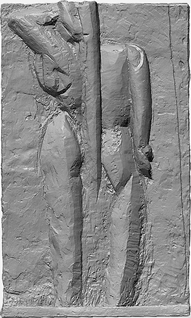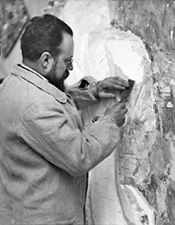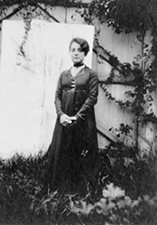

Back (III) in bronze, 1913–16. The Museum of Modern Art, New York, Mrs. Simon Guggenheim Fund, 1952.

Three-dimensional digital model,
Back (III).
Back (III), by May 13, 1913–early fall 1916
Matisse worked on Back (III) intermittently for over three years, starting from a plaster of the previous cast. He straightened the figure’s spine, eliminated details, emphasized vertical elements in the pose, and widened the overall form. The most pronounced element is the spine or column of hair, which seems to clamp the figure onto the surface and press it into and across the ground. In many ways, this flattening and sectioning of form recalls the effect of the Cubist grid that Matisse adopted in paintings of the same period, most especially Bathers by a River.

Matisse working from Back (II) to Back (III), May 13, 1913, a photograph by Alvin Langdon Coburn. Archives, International Museum of Photography at George Eastman House, Rochester, New York.
On May 13, 1913, Alvin Langdon Coburn photographed Matisse working on Back. We can see how the artist has covered the surface with varying intensities of slip (a thin mix of clay and water), or possibly tint or varnish, in order to better distinguish the marks he was making with his knife and chisels. Comparing the changes recorded in the photograph as well as the digital scans of the completed sculptures suggests that the work shown here is likely Back (II) on its way to becoming Back (III).

Marguerite Matisse standing in the garden at Issy, c. 1915 or 1916, with Back (III) in process in the background. Archives Henri Matisse, Paris.
This image was presumably taken when Matisse and his family returned to Issy in the summer of 1915, after the French military’s occupation of their home, when the family reassembled the artist’s studio and its contents. We can see a bas-relief in the background that no longer resembles the one documented in Coburn’s photograph; instead, it is far more vertically structured, more like stone than flesh and closer to the final form of Back (III).




